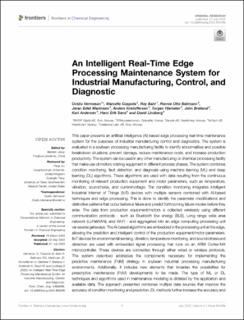| dc.contributor.author | Vermesan, Ovidiu | |
| dc.contributor.author | Coppola, Marcello | |
| dc.contributor.author | Bahr, Roy | |
| dc.contributor.author | Bellmann, Ronnie Otto | |
| dc.contributor.author | Martinsen, Jøran Edell | |
| dc.contributor.author | Kristoffersen, Anders | |
| dc.contributor.author | Hjertaker, Torgeir | |
| dc.contributor.author | Breiland, John | |
| dc.contributor.author | Andersen, Karl | |
| dc.contributor.author | Sand, Hans Erik | |
| dc.contributor.author | Lindberg, David | |
| dc.date.accessioned | 2022-09-19T14:51:25Z | |
| dc.date.available | 2022-09-19T14:51:25Z | |
| dc.date.created | 2022-05-26T21:01:46Z | |
| dc.date.issued | 2022 | |
| dc.identifier.citation | Frontiers in Chemical Engineering. 2022, 4, 900096. | en_US |
| dc.identifier.issn | 2673-2718 | |
| dc.identifier.uri | https://hdl.handle.net/11250/3018996 | |
| dc.description.abstract | This paper presents an artificial intelligence (AI) based edge processing real-time maintenance system for the purposes of industrial manufacturing control and diagnostics. The system is evaluated in a soybean processing manufacturing facility to identify abnormalities and possible breakdown situations, prevent damage, reduce maintenance costs, and increase production productivity. The system can be used in any other manufacturing or chemical processing facility that make use of motors rotating equipment in different process phases. The system combines condition monitoring, fault detection, and diagnosis using machine learning (ML) and deep learning (DL) algorithms. These algorithms are used with data resulting from the continuous monitoring of relevant production equipment and motor parameters, such as temperature, vibration, sound/noise, and current/voltage. The condition monitoring integrates intelligent Industrial Internet of Things (IIoT) devices with multiple sensors combined with AI-based techniques and edge processing. This is done to identify the parameter modifications and distinctive patterns that occur before a failure and predict forthcoming failure modes before they arise. The data from production equipment/motors is collected wirelessly using different communication protocols - such as Bluetooth low energy (BLE), Long range wide area network (LoRaWAN), and Wi-Fi - and aggregated into an edge computing processing unit via several gateways. The AI-based algorithms are embedded in the processing unit at the edge, allowing the prediction and intelligent control of the production equipment/motor parameters. IIoT devices for environmental sensing, vibration, temperature monitoring, and sound/ultrasound detection are used with embedded signal processing that runs on an ARM Cortex-M4 microcontroller. These devices are connected through either wired or wireless protocols. The system described addresses the components necessary for implementing the predictive maintenance (PdM) strategy in soybean industrial processing manufacturing environments. Additionally, it includes new elements that broaden the possibilities for prescriptive maintenance (PsM) developments to be made. The type of ML or DL techniques and algorithms used in maintenance modeling is dictated by the application and available data. The approach presented combines multiple data sources that improve the accuracy of condition monitoring and prediction. DL methods further increase the accuracy and require interpretable and efficient methods as well as the availability of significant amounts of (labeled) data. | en_US |
| dc.language.iso | eng | en_US |
| dc.publisher | Frontiers | en_US |
| dc.rights | Navngivelse 4.0 Internasjonal | * |
| dc.rights.uri | http://creativecommons.org/licenses/by/4.0/deed.no | * |
| dc.subject | Industrial internet of things | en_US |
| dc.subject | Artificial intelligence | en_US |
| dc.subject | Predictive maintainance | en_US |
| dc.subject | Industry 5.0 | en_US |
| dc.subject | Machine learning | en_US |
| dc.subject | Deep learning | en_US |
| dc.subject | AI-based processing | en_US |
| dc.subject | Edge processing | en_US |
| dc.title | An Intelligent Real-Time Edge Processing Maintenance System for Industrial Manufacturing, Control, and Diagnostic | en_US |
| dc.title.alternative | An Intelligent Real-Time Edge Processing Maintenance System for Industrial Manufacturing, Control, and Diagnostic | en_US |
| dc.type | Peer reviewed | en_US |
| dc.type | Journal article | en_US |
| dc.description.version | publishedVersion | en_US |
| dc.rights.holder | © 2022 Vermesan, Coppola, Bahr, Bellmann, Martinsen, Kristoffersen, Hjertaker, Breiland, Andersen, Sand and Lindberg. | en_US |
| dc.source.pagenumber | 18 | en_US |
| dc.source.volume | 4 | en_US |
| dc.source.journal | Frontiers in Chemical Engineering | en_US |
| dc.identifier.doi | 10.3389/fceng.2022.900096 | |
| dc.identifier.cristin | 2027614 | |
| dc.relation.project | Norges forskningsråd: 308908 | en_US |
| dc.relation.project | EC/H2020/826060 | en_US |
| dc.source.articlenumber | 900096 | en_US |
| cristin.ispublished | true | |
| cristin.fulltext | original | |
| cristin.qualitycode | 1 | |

